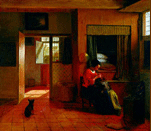17.
Female Cultures of Correspondence
Organizers:
- Ursula Appelt, English, Hanover College
- Laura Henigman, English and American Studies, James Madison University
Description:
This workshop proposes to examine the letter as a genre, its uses and potentials
for early modern women. For what purposes did early modern women write letters?
What were the conditions of production, sending, and reading? As Janet Altman
has written, the addressee (“implied reader”) is of particular importance
to the construction of the letter. Therefore, we propose that the letter is
of particular use as a locus for examining how women negotiate hierarchical
relationships and construct a range of types of networks. While the elaborate
epistolary conventions set out in manuals and collections could reinforce social
hierarchies, women writing letters could exploit those conventions as a means
of persuasion to achieve their goals, or could challenge, subvert, and tweak
those hierarchies as well. The flexibility of the genre, the common early modern
practices of dictating letters to amanuenses and of recipients sharing the content
of letters with others, all further complicate the question of how letters function,
making them useful tools to interrogate the categories of public and private.
We are particularly (though by no means exclusively) interested in examples
of women writing to other women. What happens when that “implied reader”
is a woman? What are the ways in which the various hierarchies structuring early
modern societies become, as the plenary for the conference suggests, disengaged
from each other (examples where class trumps gender, for example)? What factors
influence the formation, makeup, and workings of female epistolary networks?
Are such networks even possible in the early modern period? If so, under what
conditions, and how do they work?
It is our hope that bringing women’s letters from disparate cultural
settings together will allow us to discover reading challenges that may not
be evident when the letters remain embedded in their own contexts exclusively.
Readings for the workshop – a collection of letters from diverse settings
and time periods – will be distributed to workshop participants in advance
of the conference.





















